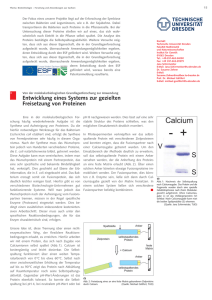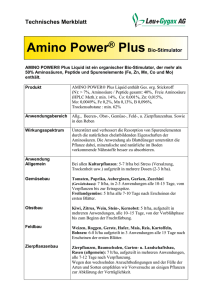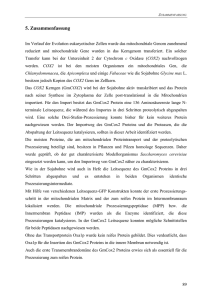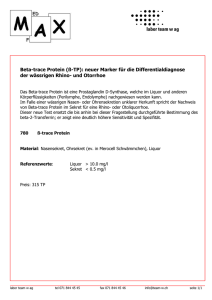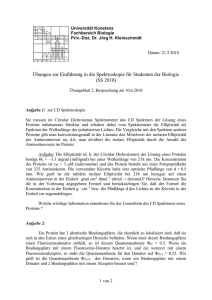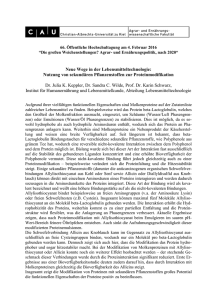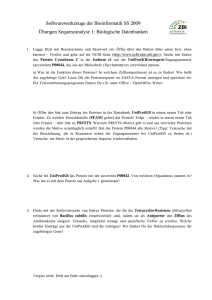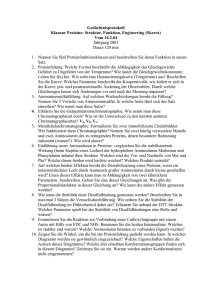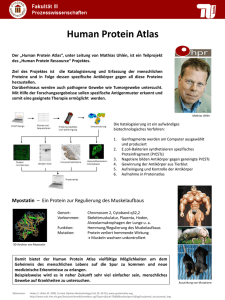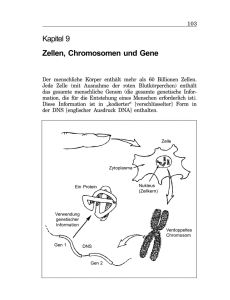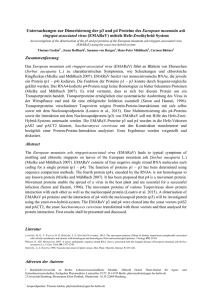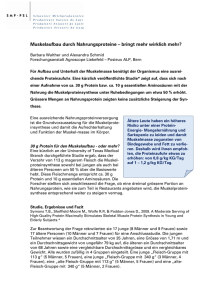„Softwarewerkzeuge der Bioinformatik“ SS09
Werbung
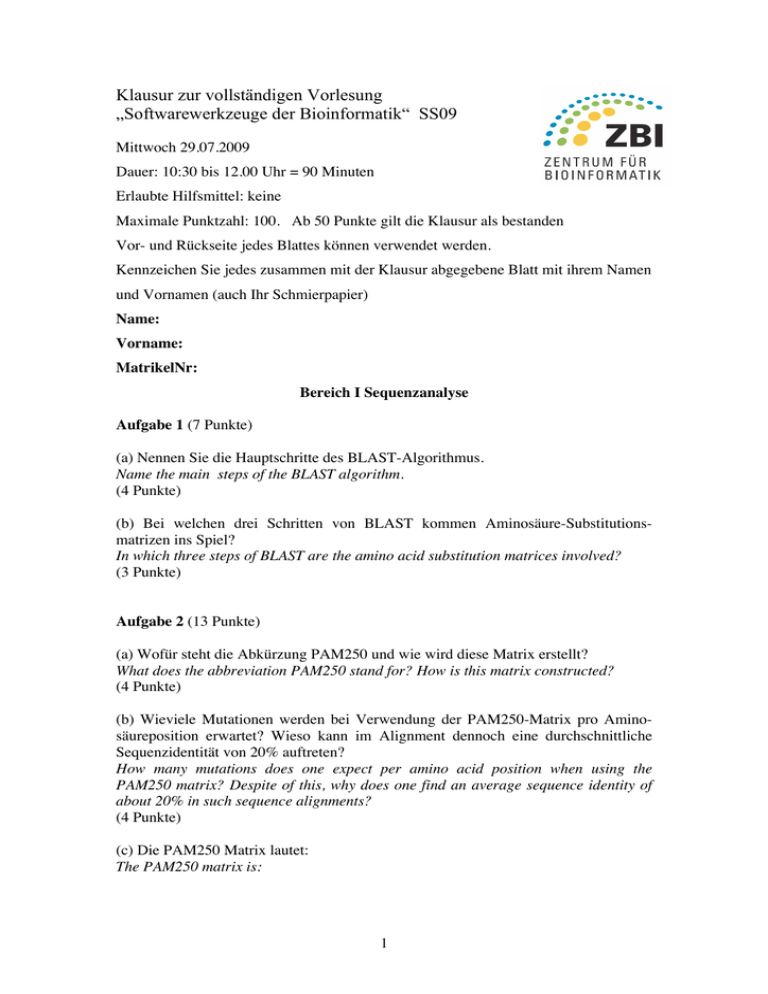
Klausur zur vollständigen Vorlesung „Softwarewerkzeuge der Bioinformatik“ SS09 Mittwoch 29.07.2009 Dauer: 10:30 bis 12.00 Uhr = 90 Minuten Erlaubte Hilfsmittel: keine Maximale Punktzahl: 100. Ab 50 Punkte gilt die Klausur als bestanden Vor- und Rückseite jedes Blattes können verwendet werden. Kennzeichen Sie jedes zusammen mit der Klausur abgegebene Blatt mit ihrem Namen und Vornamen (auch Ihr Schmierpapier) Name: Vorname: MatrikelNr: Bereich I Sequenzanalyse Aufgabe 1 (7 Punkte) (a) Nennen Sie die Hauptschritte des BLAST-Algorithmus. Name the main steps of the BLAST algorithm. (4 Punkte) (b) Bei welchen drei Schritten von BLAST kommen Aminosäure-Substitutionsmatrizen ins Spiel? In which three steps of BLAST are the amino acid substitution matrices involved? (3 Punkte) Aufgabe 2 (13 Punkte) (a) Wofür steht die Abkürzung PAM250 und wie wird diese Matrix erstellt? What does the abbreviation PAM250 stand for? How is this matrix constructed? (4 Punkte) (b) Wieviele Mutationen werden bei Verwendung der PAM250-Matrix pro Aminosäureposition erwartet? Wieso kann im Alignment dennoch eine durchschnittliche Sequenzidentität von 20% auftreten? How many mutations does one expect per amino acid position when using the PAM250 matrix? Despite of this, why does one find an average sequence identity of about 20% in such sequence alignments? (4 Punkte) (c) Die PAM250 Matrix lautet: The PAM250 matrix is: 1 Durch einen Fehler bei dem Druck eines Bioinformatik-Lehrbuchs wurden folgende vier Werte nicht eingetragen: 12, 6, 2, -5. Tragen Sie die Werte in die richtigen Kästchen ein Due to an error when printing a bioinformatics text book, the following four values (12, 6, -2, -5) were not entered into the table. Insert these values into the correct boxes. (5 Punkte) Aufgabe 3 (6 Punkte) Gegeben seien zwei alignierte Sequenzen, die an 50% der Positionen dieselbe Aminosäuren haben. Welche Aussagen sind richtig? Given are two aligned sequences that have the same amino acids in 50% of all positions. Which ones of the following statements are correct? Die Sequenzen haben eine Identität von 50%. The sequences are 50% identical. Die Sequenzen haben eine Ähnlichkeit von mindestens 50%. The sequences are at least 50% similar. Die Sequenzen sind vermutlich homolog. The sequences are likely homologous. Die Sequenzen sind mit Gewissheit homolog. The sequences are for sure homologous. Die Sequenzen sind 50% homolog. The sequences are 50% homologous. 2 Aufgabe 4 (4 Punkte) Sie führen eine Suche mit cross-species MegaBLAST durch, um das Ortholog zu einem menschlichen Gen im Genom der Maus zu finden. Dabei erhalten Sie mehrere Treffer mit ähnlich signifikanten E-Values. Für welchen entscheiden Sie sich? When conducting a search using cross-species MegaBLAST to find orthologous genes in the mouse genome of a human gene, you get several hits for which the E-values are of similar significance. Which one do you choose? Für den ersten der Trefferliste. I take the first hit on the list. Für den mit dem höchsten Score. I take the hit with the highest score. Für den, der dieselben Nachbargene hat wie beim Menschen, d.h. mit konservierter Syntenie. I take the hit that has the same neighboring genes as in human, i.e. with conserved synteny. Für den auf demselben Chromosom wie beim Menschen. I take the hit on the same chromosome as in human. Bereich II Proteinstruktur Aufgabe 5 (7 Punkte) Charakterisieren Sie die Oberflächen von löslichen Proteine, sowie die Oberflächen von integralen Transmembranproteinen bezüglich ihrer Polarität bzw. Nicht-Polarität. Unterscheiden Sie bei den Transmembranproteinen zwischen dem in die Lipidmembran eingebetteten Bereich und dem externen Bereich. Characterize the surfaces of soluble proteins as well as the surfaces of integral membrane proteins with respect to their polarity or non-polarity. For the transmembrane proteins, distinguish between the region embedded in the lipid membrane and the external region. Aufgabe 6 (9 Punkte) Das Bild zeigt die Ligandenbindungsstelle der katalytischen Untereinheit von Proteinkinase A in der Kristallstruktur des Komplexes mit dem (gelblich fett gezeichneten) Liganden Balanol. The figure shows the ligand binding site of the catalytic subunit of protein kinase A in the crystal structure of the complex with the ligand balanol that is drawn in thick, yellow lines. 3 (a) Was deuten die dünnen, beigen Linien mit den kleinen Ziffern an? What do the thin beige lines with the small numbers indicate? (3 Punkte) (b) Umkreisen und beschriften Sie in dem dünn gezeichneten Protein jeweils eine Aminosäuren der drei folgenden Typen: Tyrosin Leucin Glutaminsäure bzw. Glutamat Circle and label one copy each of the three following amino acids in the protein shown in thin lines: tyrosine leucine glutamic acid (3 Punkte). (c) Welcher Atomtyp bzw. welches chemische Element ist durch die blauen Stäbe (sticks) gekennzeichnet? Which atom type or chemical element is marked by blue sticks? (3 Punkte) Aufgabe 7 (Transferaufgabe - nicht in der Vorlesung behandelt, 10 Punkte) Man kann die Konnektivität in räumlichen, d.h. dreidimensionalen, Proteinstrukturen schematisch in zwei Dimensionen durch eine „Kontaktmatrix" („contact map“) darstellen. Für ein gegebenes Protein wird dabei auf beiden Koordinatenachsen seine Proteinsequenz aufgetragen. Überall dort, wo zwei Aminosäuren des Proteins in der räumlichen Struktur benachbart sind (d.h. zwei Atome dieser Aminosäuren haben einen Abstand von weniger als z.B. 8 Å) wird ein Kreuz/Quadrat markiert. The connectivity in three-dimensional protein structures can be shown in two dimensions by using a “contact map”. For a given protein, both axes of the coordinate system list the protein sequence. 4 Whenever two amino acids of the protein are neighbors in the 3D structure (i.e. two atoms of those amino acids have a distance shorter that e.g. 8 Å), this incidence will be marked by a cross/square. Entwerfen und beschreiben Sie in Stichworten einen Algorithmus, wie man anhand der Kontaktmatrizen zweier Proteine die Ähnlichkeit der räumlichen Strukturen beider Proteine bestimmen kann. (Anmerkung: genau dies macht das Programm DALI). Develop and describe briefly an algorithm to characterize the similarity of the 3D structures of two proteins on the basis of their contact matrices. (Comment: exactly this is done by the program DALI). Bereich III Genexpression Aufgabe 8 (11 Punkte) (a) Erklären Sie die Idee des Zweifarben-Microarray Experiments. Explain the concept of the two color microarray experiment. (4 Punkte) (b) Was für Daten werden mit dieser experimentellen Technik gewonnen? What kind of data is abtained from this experimental technique? (3 Punkte) (c) Welche Schritte wurden in der Vorlesung zur Prozessierung vorgestellt? Which processing steps were introduced in the lecture? (4 Punkte) Bereich IV Dynamische Netzwerke Aufgabe 9 (10 Punkte) 5 (a) Gegeben sei ein Substrat A, das in das Produkt B umgewandelt wird. Skizzieren Sie die zeitabhängige Konzentration des Produkts B, wenn zum Zeitpunkt t = 0 eine gewisse Menge A zugegeben wird. Unterscheiden Sie zwischen der direkten Reaktion A => B und einer mehrstufigen Umwandlungskette A => M1 => M2 => M3 => B, die über die drei Zwischenprodukte M1, M2, M3 verläuft. Given a substrate A that is converted into the product B. Sketch how the density of the product B evolves with time when at t = 0 a certain amount of A is added. Compare between the direct reaction A => B and a multi step reaction cascade A => M1 => M2 => M3 => B via the intermediates M1, M2, and M3. (6 Punkte) (c) Was ist der wesentliche Unterschied zwischen einem Attraktor eines Booleschen Netzes und einem stationären Zustand eines Ratengleichungsmodells? What is the major difference between an attractor of a Boolean network and the steady state of a rate equation model? (4 Punkte) Aufgabe 10 (12 Punkte) (a) Wie kann man in einem Experiment unterscheiden, ob ein Inhibitor kompetitiv oder nicht-kompetitiv auf ein Enzym wirkt? How can one discern experimentally whether an inhibitor acts competitively or noncompetitively onto an enzyme? (4 Punkte) (b) Was beschreibt die „Hill-Kinetik“? Erläutern Sie die Unterschiede zur MichaelisMenten-Enzymkinetik anhand einer Skizze. What does the „Hill kinetics“ describe? Use a sketch to explain the differences between Hill- and Michaelis-Menten enzyme kinetics. (5 Punkte) (c) Unter welchen Voraussetzungen sind effektive Kinetiken eine brauchbare Vereinfachung gegenüber der expliziten Modellierung? Under which conditions are effective kinetics a useable approximation to an explicit description? (3 Punkte) Aufgabe 11 (11 Punkte) (a) Welche relative Unsicherheit der Teilchenzahl würde man bei 25, 3700 bzw. 106 Teilchen jeweils erwarten? Warum? How large is the relative uncertainty of the particle number that you would expect for 25, 3700, or 106 particles, resp.?Why? (4 Punkte) (b) Was ist die grundlegende Idee des Gillespie-Algorithmus? Skizzieren Sie den Algorithmus anhand der einfachen Zerfallsreaktion A => Ø. What is the basic idea of the Gillespie algorithm? Briefly explain the algorithm for the simple decay reaction A => Ø. (7 Punkte) 6
